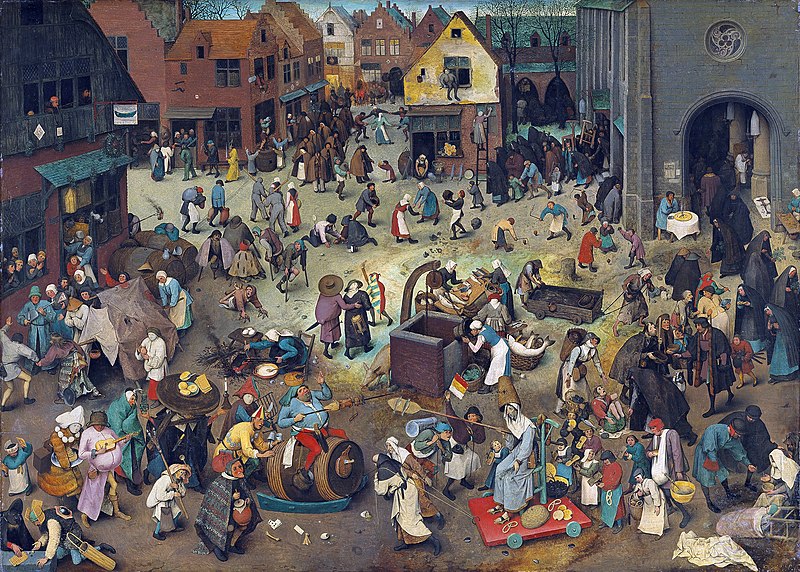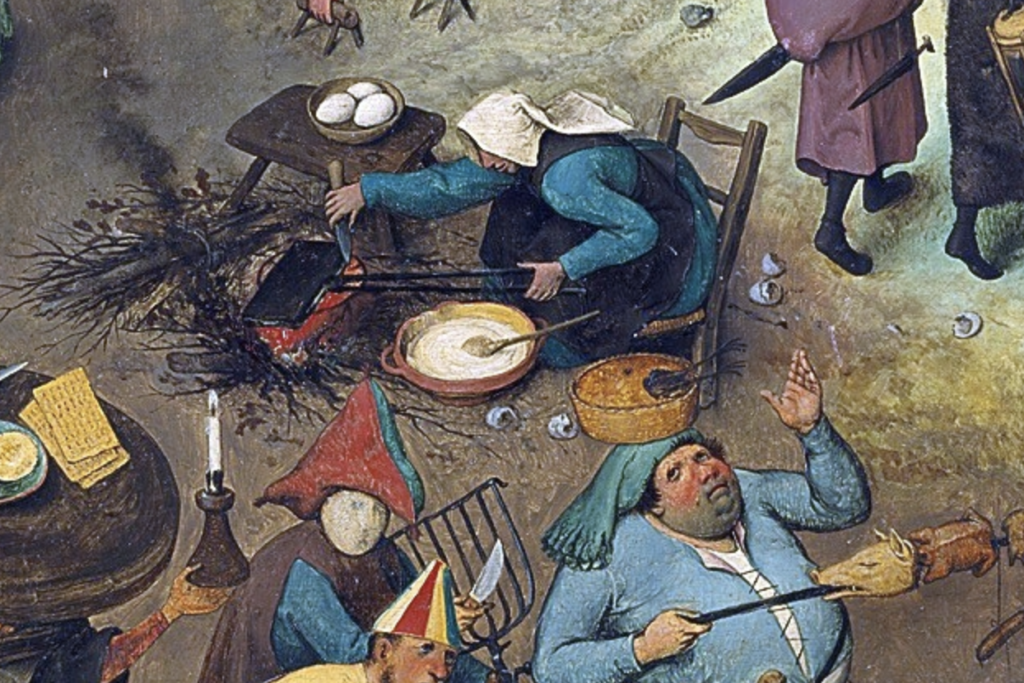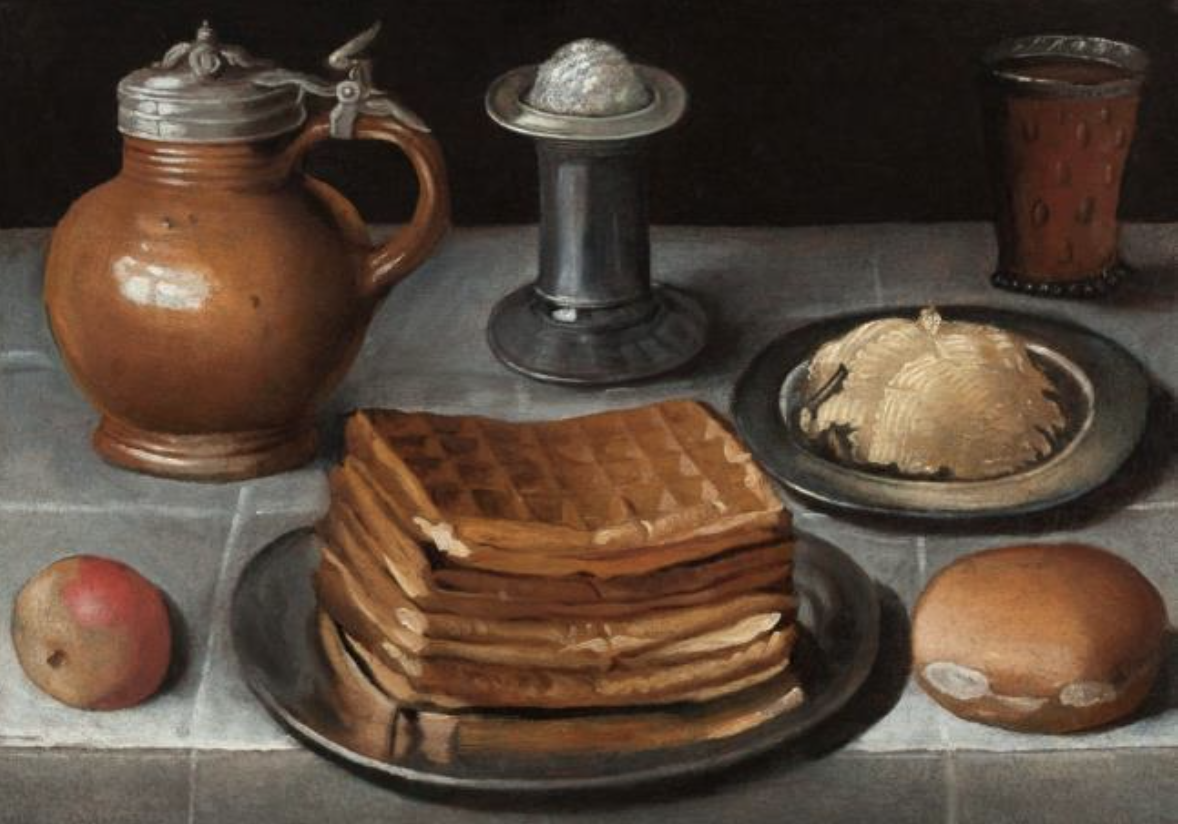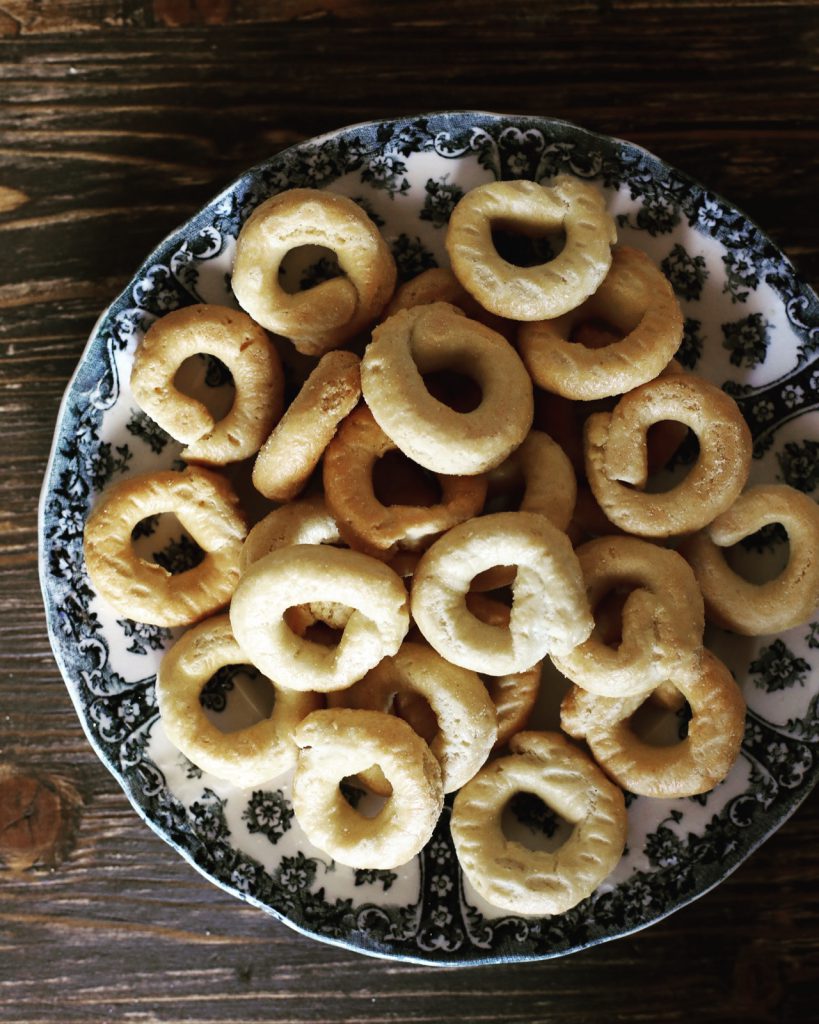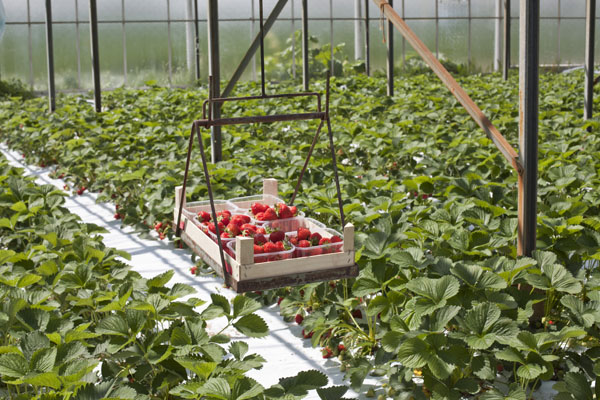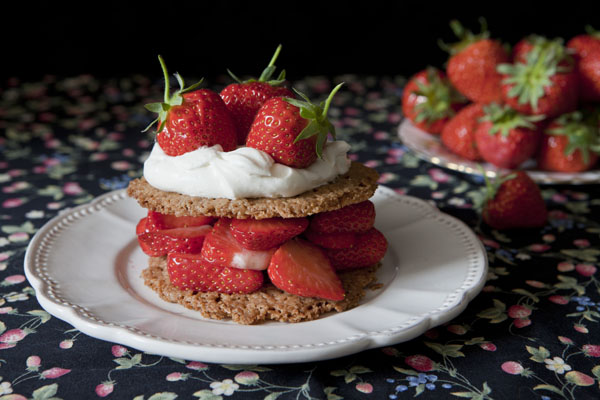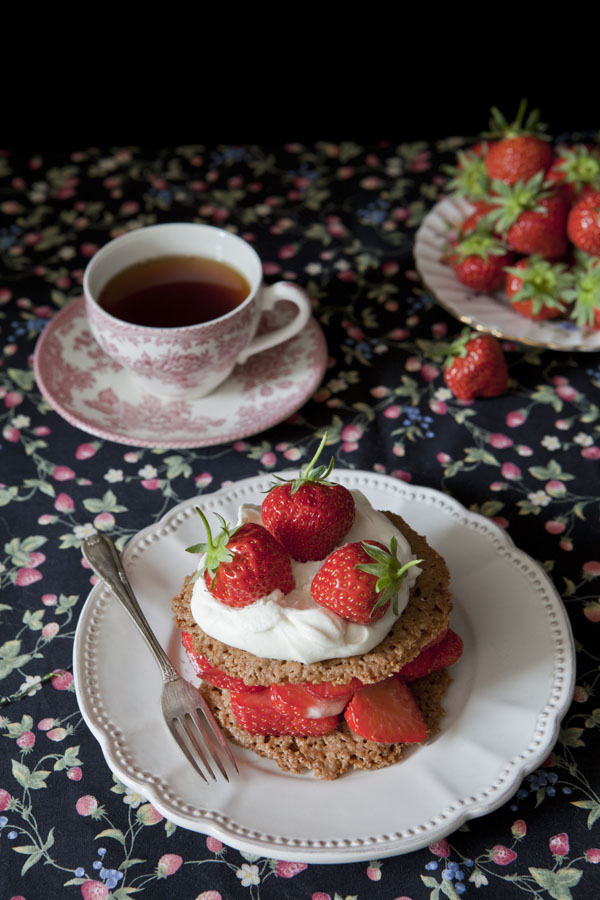The post My first Podcast episode on ‘Regula Culinaria’: Fat Tuesday appeared first on Miss Foodwise.
]]>‘De strijd tussen Vastenavond en Vasten’ is een schilderij uit 1559, geschilderd door Pieter Bruegel de Oude. Het toont ons meteen wat de kookboeken uit die tijd en later ook verraden…
Wafel recept uit een 16de eeuws handschrift
Dit recept maakt een lopend beslag zoals het beslag dat we zien op het werk van Pieter Bruegel de Oude. Het bestaat uit bier, verse gist of biergist, gesmolten boter, eieren en lichtbruin meel.
Om te maicken dicke wafelen
Neemt zess eijeren mit dat witte ende zess sonder wit ende slaetse wel cleijn mit een lepel vol versche ghest mit een half cruijse warm biers, die helfte meer boters gesmauten mit den bier, mit veel suijckers alsoe dattet wel soet is, ende dan neemt gebudelt meel ende menget wat dicker dan die lepel daer in overeijnt in staen mach , ende mengetse eenen halven dach te voeren eer ghijse backet ende setse bij tvier dattet warm blijft ende maict het vier van koelen ende maket yser wel heet ende doet dat deech daer in ende backsche ende neemt versche boter ende doet daer suijcker in ende maect die boter wel heet ende ghietse over die waefelen.
476 UB Gent
Het Carnaval van Binche
Het is een 400 jaar oude traditie die zo belangrijk wordt geacht dat het in 2004 de Unesco-wereld- erfgoed status kreeg.
Verdere links
Voor het carnavals recept van de Italiaans – Toscaanse Cenci moet je hier zijn: bij Julskitchen
Regula Culinaria
Vergeet mijn podcast niet toe te voegen aan je favoriete podcast app (Apple podcast neemt 10 dagen om een nieuwe podcast goed te keuren dus voorlopig enkel via de link hier of in je spotify app), en ‘subscribe’ in de rechter kolom bovenaan om bericht te krijgen van een nieuwe aflevering. Voorlopig zal er eens per maand een aflevering online komen.
The post My first Podcast episode on ‘Regula Culinaria’: Fat Tuesday appeared first on Miss Foodwise.
]]>The post Jumbles on the battlefield appeared first on Miss Foodwise.
]]>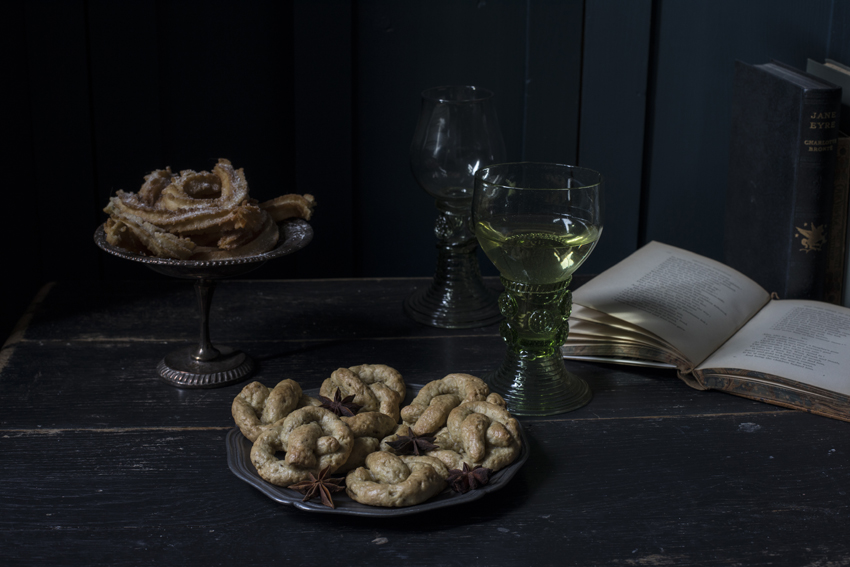 It has been a busy few months, flying from photography assignments and meetings in London to Latvia for research, London again, then to New York, two days after to Milan, then London again, then Milan again a few days ago. I have been spreading myself too thin, so over the Easter weekend, my first weekend home since somewhere in februari, I barricaded myself onto the sofa between stacks of pillows and two sleepy cats.
It has been a busy few months, flying from photography assignments and meetings in London to Latvia for research, London again, then to New York, two days after to Milan, then London again, then Milan again a few days ago. I have been spreading myself too thin, so over the Easter weekend, my first weekend home since somewhere in februari, I barricaded myself onto the sofa between stacks of pillows and two sleepy cats.
We are talking Jumbles today and I don’t mean gibberish.
I was following ‘A History of Royal Food and Feasting’, a fun free online course from the University of reading and Historic Royal Palaces with a lot of interesting historical information about food. A lot of the information I already knew but I did manage to learn a few things, plus it was just great fun to do and force myself to take some rest while still being productive. One of the dishes that were recommended to try on the course were Jumbles, a biscuit I had been meaning to bake but haven’t had the time in my mad schedule. When the Learning and Engagement department got in touch to check if I wanted to get involved to spread the word about the course I of course said yes because I enjoyed it. So Jumbles it was!
Jumbles were knot shaped biscuits that first appeared in the wonderful book The good Huswifes Jewell by Thomas Dawson, dating to 1585. But legend places this biscuit right at the heart of The War of the Roses a century before Dawson’s recipe.
For those who are unfamiliar with English history The Wars of the Roses were a series of battles fought in the period of 1455 to 1485 between two rival branches of the royal House of Plantagenet, the House of York and the house of Lancaster – both sporting a rose in their heraldic emblem. Both made a claim for the throne of England. They were a result from the social and financial problems following the Hundred Years’ War. The Lancastrian claimant, Henry Tudor defeated the last king of the House of York, Richard III at Bosworth Field, near Market Bosworth, a market town in Leicestershire. He then married Edward IV’s daughter, Elizabeth of York, to unite the two houses.
And it is precisely on this last battlefield that a new legend was born, at least a few centuries later…
The story goes that Richard III’s chef brought biscuits to the battlefield. These were even thought to be his speciality and the favourite of the king. After the battle when survivers were stealing valuables from the dead as was the custom, a recipe for these biscuits was found – because you should never go to war without at least one good biscuit recipe! The biscuits were promptly named Bosworth Jumbles. Or so the legend says since around the 1980’s.
To make Iombils a hundred.
Take twenty Egges and put them into a pot both the yolkes & the white, beat them wel, then take a pound of beaten suger and put to them, and stirre them wel together, then put to it a quarter of a peck of flower, and make a hard paste thereof, and then with Anniseede moulde it well, and make it in little rowles beeing long, and tye them in knots, and wet the ends in Rosewater, then put them into a pan of seething water, but euen in one waum, then take them out with a Skimmer and lay them in a cloth to drie, this being doon lay them in a tart panne, the bottome beeing oyled, then put them into a temperat Ouen for one howre, turning them often in the Ouen.
The good Huswifes Jewell by Thomas Dawson (London, 1585).
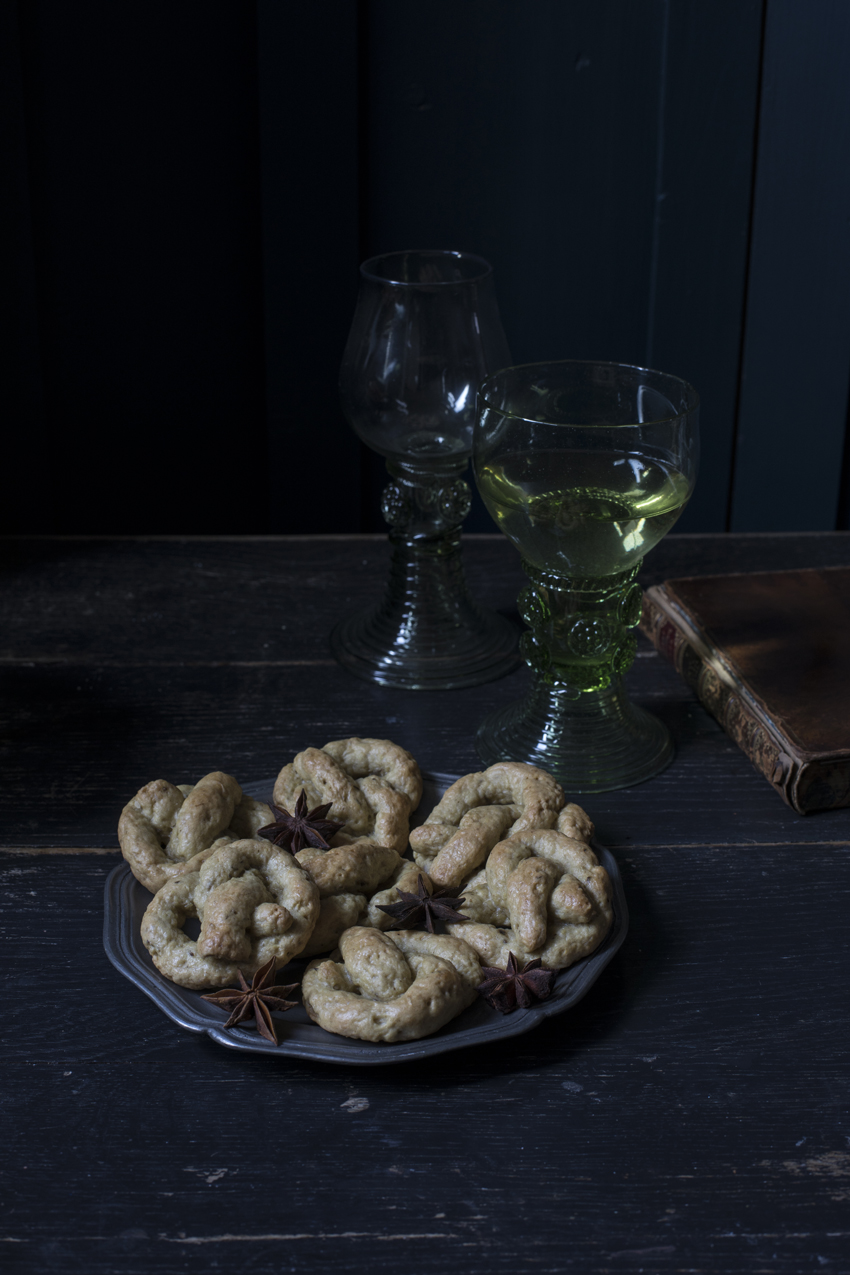 Although the word ‘jumble’ means ‘to make a hodgepodge out of things’ leading you to think it is called that way because of mixing a bunch ingredients, it is thought to come form the Latin ‘gemellus’ meaning ‘twins’ which might refer to the shape of the knot. It is a possibility since there is also a biscuit in Italy called ‘gemelli’ as in the Italian word for twins. In France there is the ‘gimblette’ a donut shaped biscuit which was hung from a rosemary branch on Palm Sunday in order to be blessed. Popular flavourings are candied peel and orange blossom water, sometimes also aniseed. The biscuits are first boiled, then baked, like the early English recipe also instructs. The Larousse gives as explanation for this bake: Petit gâteau en couronne, parfumé aux amandes. Spécialité d’Albi. No mention of the other flavourings. But I am not alarmed as The Larousse is often incomplete or wrong!
Although the word ‘jumble’ means ‘to make a hodgepodge out of things’ leading you to think it is called that way because of mixing a bunch ingredients, it is thought to come form the Latin ‘gemellus’ meaning ‘twins’ which might refer to the shape of the knot. It is a possibility since there is also a biscuit in Italy called ‘gemelli’ as in the Italian word for twins. In France there is the ‘gimblette’ a donut shaped biscuit which was hung from a rosemary branch on Palm Sunday in order to be blessed. Popular flavourings are candied peel and orange blossom water, sometimes also aniseed. The biscuits are first boiled, then baked, like the early English recipe also instructs. The Larousse gives as explanation for this bake: Petit gâteau en couronne, parfumé aux amandes. Spécialité d’Albi. No mention of the other flavourings. But I am not alarmed as The Larousse is often incomplete or wrong!
Another biscuit I find closely linked to the English Jumble, Italian gemelli and the French ‘gimblette’ is another Italian biscuit, this one from the island of Burano: the Buranelli or Bussolai Buranei. Often also called Essi when it is shaped in an S-shape instead of donut. Though theories on this site claim it was made for fishermen, I find it a little unbelievable since working class people would not have been able to afford the sugar. Traditional stories place the Buranelli or Bussolai Buranei around Eastertime, just like the French Gimblette. The island website of Burano tells the romantic tale that it was a tradition of Burano, a few days before Easter for the women to rent the ovens of the island’s bakeries to bake their bussolai for Easter. It is quite possible that this did indeed happen as it was a general custom all over Europe for people to go to their town or village bakery to have their bread, meat or beans cooked or baked. In Puglia and in Napoli they have a biscuit which is probably the most similar to the English Jumble: the Taralli. This biscuit, although always savoury is also first boiled then baked.
In the 16th century there was also the gimmell ring, again referring to the Latin word for twin ‘gemellus’ as mentioned earlier. The ring was made from two intersecting bands and if you hold them away from one and other they do kind of look like a pretzel or our old jumbles. My favourite 17th century poet Robert Herrick mentions the ring in one of his poems and he even calls it ‘a ring of jimmals’. I’ve always been intrigued by his words.
THOU sent’st to me a true love-knot, but I
Returned a ring of jimmals to imply
Thy love had one knot, mine a triple tie.
Works of Robert Herrick. vol I. Alfred Pollard, ed. London, Lawrence & Bullen, 1891. 217.
I find another possible early link in Bartolomeo Sacchi – Platina – De honesta voluptate et valetudine, dated around 1465. There the author shares a recipe for a ‘pastry which they call canisiones’ which he says to form into rolls, and bake in a gentle oven just like the recipe for marzipan confections on the page before. Jumbles in England were also sometimes made not from flour, eggs and butter, but from a sugar and fruit paste, or almond meal, very much resembling the marzipan biscuits of Platina.
‘Apricock Jumballs’ from an 18th century recipe from ‘English Housewifery Exemplified’ written by Elizabeth Moxon is such a flourless jumble, consisting only from sugar and apricots cooked until they become a stiff paste like fruit cheese. These were then cut in strips and made into complex knot creations which you can see in some Dutch still life paintings.
In the 17th century they also appeared in books and recipes can be found in Hugh Plat’s The Arte of Preserving Conserving… of 1609 and in The English Huswife by Gervase Markham in 1615. By then the dough was no longer boiled before being baked. Flavourings still include the traditional and still popular aniseed and caraway seeds. Sometimes sugar was added, sometimes it was left out. Rosewater is still being used, even as an icing mixed with sugar and egg white. While Plat instructs to create knots and uses almond meal and grated biscuits, Markham says you can make them in whatever shape you want and uses wheat flour.
Jumbles were mostly popular in the 18th century where they were served with wine, just like Italian biscotti to dip in Vinsanto.
Later recipes use yeast, presumably to create a lighter bake, then yeast is replaced by baking powder. In the 20th century all shapes are a go and jumbles are even made into letters as instructed in the Reform Cookery Book‘ by Mrs. Mill in 1909. Recipes for jumbles today, like used on the Bake Off last year, are more crumbly and short textured.
The recipe
I chose to give you the recipe which calls for poaching the biscuits like the earliest recipes stated because I tested the biscuits only baking them and the poached ones came out much nicer and covered in a pearly exterior as if they had been egg washed. The baked ones were just looking like a dry biscuit. They are dry though, don’t think like you’re going to experience a nice short texture, it is definitely more chewy and I assume these biscuits were made to keep relatively long. It is even possible they would have used them for decoration too. In any case I am keeping some to see how long they keep and as soon as I break my tooth on one.
What do you need
- 70 g raw cane sugar
- 1 tsp caraway or aniseed
- 2 eggs
- 1 tbsp full-fat milk
- A pinch of salt
- 200 g all-purpose flour
- 1 tsp rosewater
Method
Use a mortar and pestle to crush the caraway or aniseeds, if your mortar is large enough, add the sugar and bash them together to get the flavour into the sugar.
Transfer seeds and sugar to a large bowl and mix in the eggs and milk.
Add the pinch of salt and the flour and work the mass into a stiff dough.
The dough is quite dry, yet still a little sticky, but that is what you need to roll it out succesfully.
Leave the dough to rest for an hour or so if you have the time, if not, proceed by rolling out the dough in 26 cm snakes for the knots.
Preheat your oven to 180°c and place a baking tray in it to get hot. Keep another baking tray aside and line it with kitchen paper or a tea towel.
Keep a fine pastry brush and 1 tsp of rosewater ready in a small bowl, I tend to use an eggcup for this. Make the knots like for pretzels or any other knot shape you desire. Use the rosewater to moisten the ends of the snakes to attach them to the knot, it might seem like they do not stick together but leave them for a few minutes while you do your other knots and you will see they are stuck together.
Bring a generous amount of water to a simmer in a large pot.
Have a spatula ready to immerse the knots into the water and poach them for 10 minutes.
Transfer the knots onto the baking tray you lined with the kitchen paper or tea towel and dry them gently.
Now line the hot baking tray with baking parchment and arrange the knots onto it. Bake them in the middle of the oven for 25-30 minutes or until the biscuits start to blush a little orange, they should not be baked golden brown.
Transfer to a wire rack and leave to cool.
Further reading
Ivan Day’s post here >
In which he mentions something interesting about these knot biscuits:
In The New World of English Words (London: 1678) Edward Phillips defines the name for this confection thus, ‘Jumbals, a sort of Sugared past, wreathed into knots’. These knotted delicacies were usually made with a kind of biscuit or marchpane dough and were baked. They probably emerged from the craze in the 1570s for knotted strap work.
The inventory of the culinary heritage of France: Midi-Pyrénées, Éditions Albin Michel, 1996
The post Jumbles on the battlefield appeared first on Miss Foodwise.
]]>The post Strawberry Spelt Shortcake, the history of Shortcake in Britain appeared first on Miss Foodwise.
]]>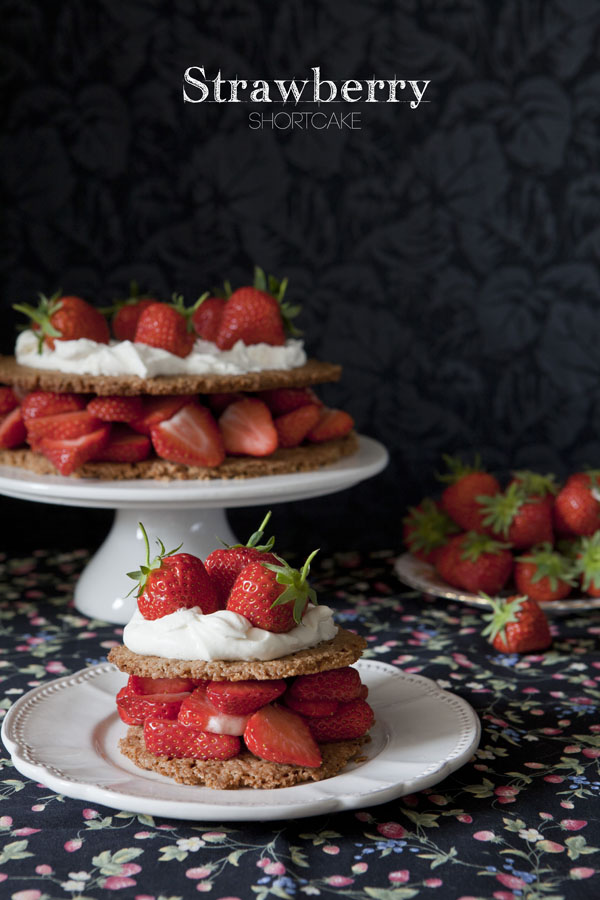
A Strawberry shortcake can take on many forms, it can be a scone-like cake, a sponge or a thin biscuit but two things remain the same throughout any recipe: fresh strawberries and lots of pretty whipped cream. Strawberries were first cultivated by the Romans in 200 BC but what about the origin of a Strawberry Shortcake?
In Medieval times newly-weds would be presented with a soup made of strawberries and sour cream topped with borage and sugar. They believed strawberries to be an aphrodisiac, yet no biscuit or cake of any kind accompanied the dish.
Short meaning crumbly from the Old English ‘cruma’ is a term that came to be in the 15th century, adding a large amount of fat or ‘shortening’ to flour results in a crumbly or ‘short’ texture.
In the Elizabethan cookbook The good Huswifes Handmaide
for the Kitchin. (1594 -1597) one can find the earliest record of the term ‘short cake’. Unfortunately none of the manuscripts that survived of this book are complete.
Take wheate flower, of the fayrest ye can get, and put it in an earthern pot, and stop it close, and set it in an Ouen and bake it, and when it is baken, it will be full of clods, and therefore ye must searse it through a search: the flower will haue as long baking as a pastie of Uenison. When you haue done this, take clowted Creame, or els sweet Butter, but Creame is better, then take Sugar, Cloues, Mace, and Saffron, and the yolke of an Egge for one doozen of Cakes one yolke is ynough: then put all these foresaid things together into the cream, & temper them al together, then put them to your flower and so make your Cakes, your paste wil be very short, therefore yee must make your Cakes very litle: when yee bake your cakes, yee must bake them vpon papers, after the drawing of a batch of bread.
A mention of a shortcake appears in one of Shakespeare’s plays ‘The Merry Wives of Windsor’ in 1602:
“Book of Riddles! why, did you not lend it to Alice Shortcake upon All-hallowmas last, a fortnight afore Michaelmas?”
After some research into these words and the help of some people who studied Shakespeare I found out that Alice was possibly the Countess of Derby who lived at that time and would have dispensed lard cakes referred to as short cakes to the poor. It is very possible that Shakespeare used Alice Shortcake as a nickname for Alice spencer the Countess of Derby but of course we are not entirely sure to say it is a fact.
What
fact is that the British have been enjoying Strawberry short cakes with
great pleasure for as long as anyone can remember and everyone seems to
have his or her own version of the dish. So here I shall bring you
mine, a ‘short’ thin wholemeal spelt biscuit that really lets the
strawberries and cream be the queen of the pudding.
This dish brings a bit of sunshine to your table, and dear oh dear do we need some sunshine is this dullest and coldest of springs.
I’m getting ready to travel to London for Food Blogger Connect, a conference where I will be one of the speakers this year. To those I will meet there, see you soon and to all the other lovely people, next time there will be yet another book from a friend on the blog!
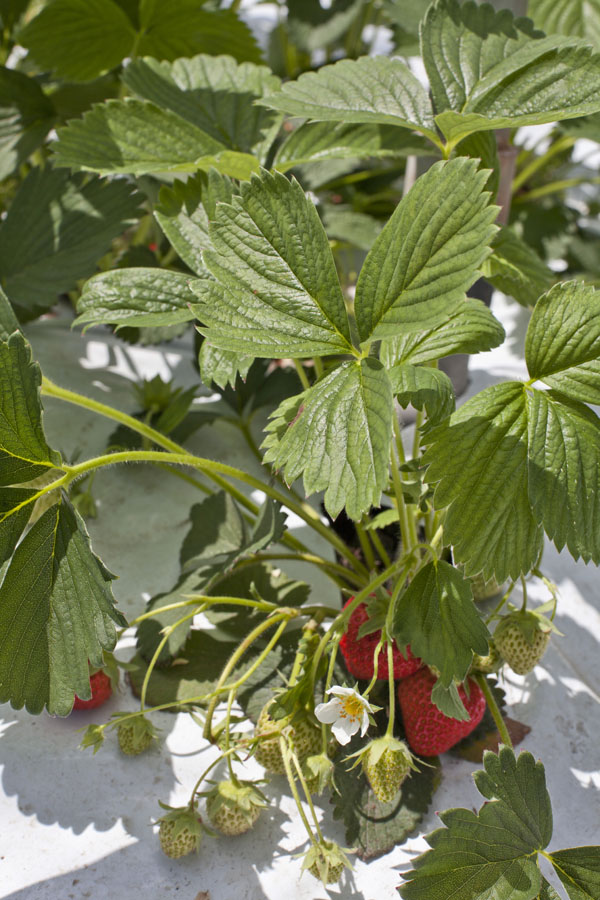 |
| from bloom to fruit |
 |
| My local strawberry farm |
Strawberry spelt shortcake
What do you need
Pastry
- 225 g cold butter
- 225 g wholemeal spelt flour
- 1 organic egg, beaten
- 100 g raw cane sugar
- vanilla, half a teaspoon
- salt, a pinch
For the filling and topping
- 300 – 500 g of strawberries, halved or quartered
- whipping cream 250 g
- 1 teaspoon of sugar to sweeten the cream
Method
- Place the butter and the flour in a bowl rub together until the mixture resembles breadcrumbs.
- Add sugar, salt and vanilla and work the dough until it comes together as a smooth pastry
- Roll out the dough until it is half a centimeter thick on a clean floured work surface
- Cut out circles of about 9 cm or two larger if you like to bake a large short cake
- Transfer the pastry circles onto greaseproof paper and chill for 30-50 minutes.
- Preheat your oven to 170° C
- Arrange the shortcakes on a baking tray – using the greaseproof paper to bake them on
- Put in the middle of the oven an bake for 20-25 minutes or until golden
- The mixture will spread while baking, don’t be alarmed by this, you can neaten the edges while warm.
- Transfer the cakes carefully to a wire rack to cool
- Cut your strawberries but leave some whole for decoration. Whip your cream.
- When the short cakes are completely cooled, arrange one shortcake on a plate or cake stand and cover it with the sliced strawberries, place another shortcake on top and top it with the whipped cream and the whole strawberries you saved for decoration.
- Serve straight away!
Note that some recipes require you to cut the strawberries, arrange them over your shortcake and let it sit for an hour before adding the top short cake and cream, I do not prefer to do so as the shortcake will get soggy and we won’t want a soggy bottom won’t we!
You might also like
apple and blackberry pie
Cornish splits
The post Strawberry Spelt Shortcake, the history of Shortcake in Britain appeared first on Miss Foodwise.
]]>
